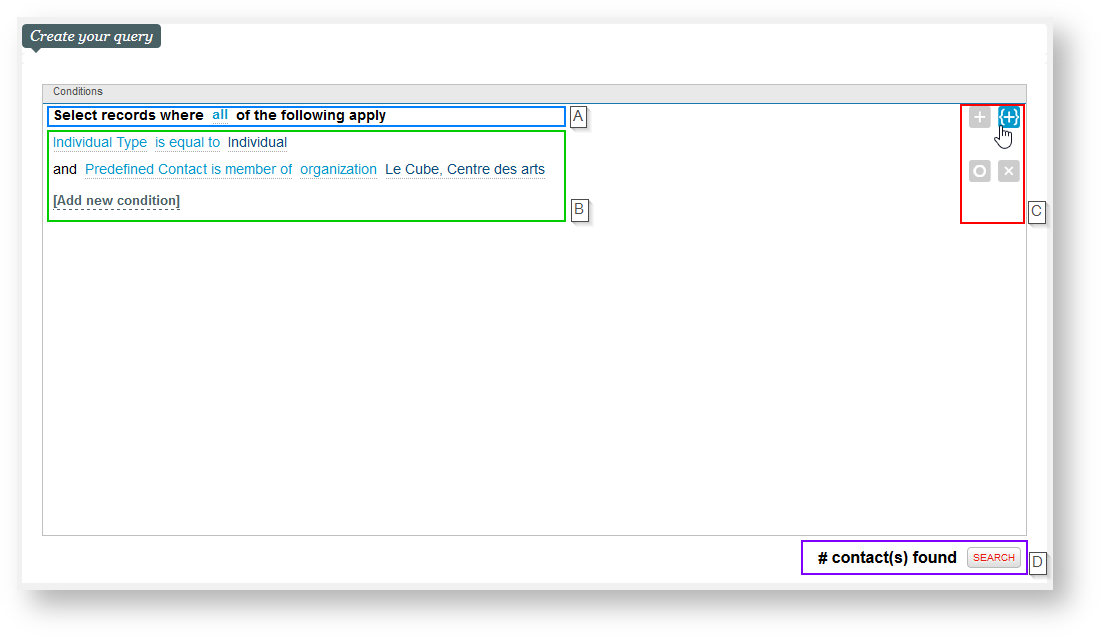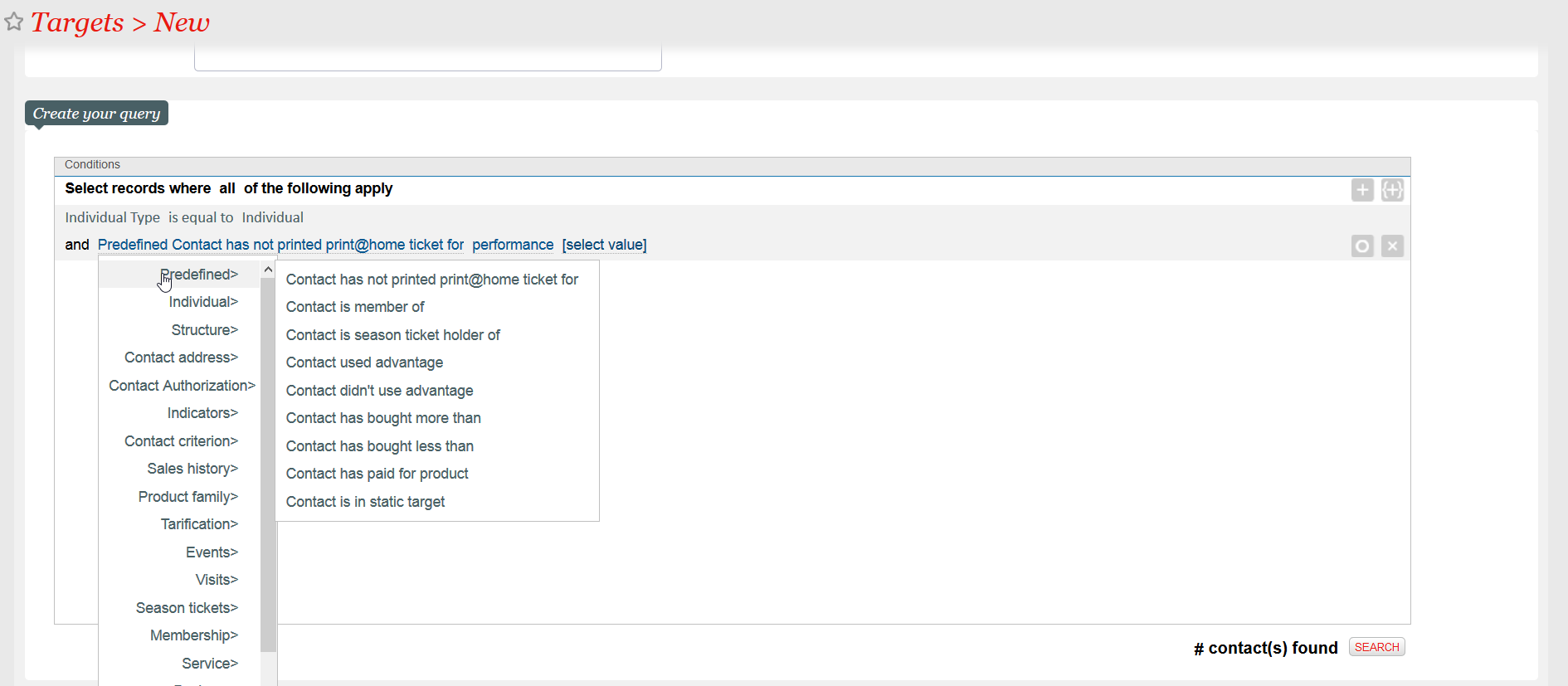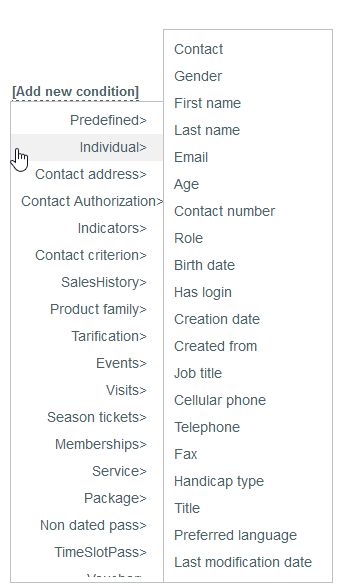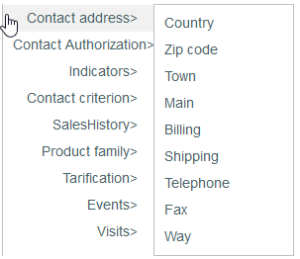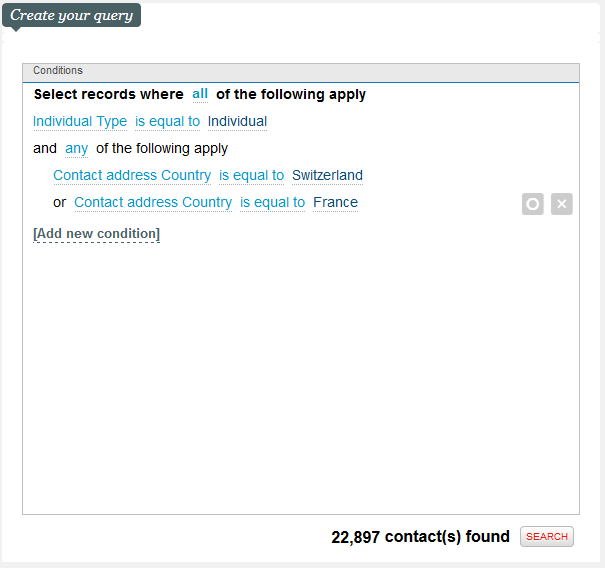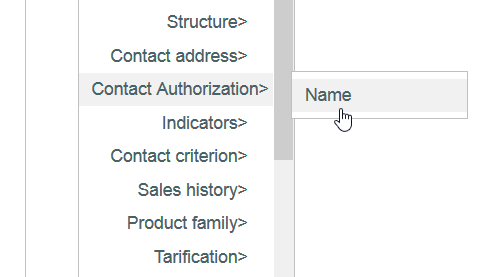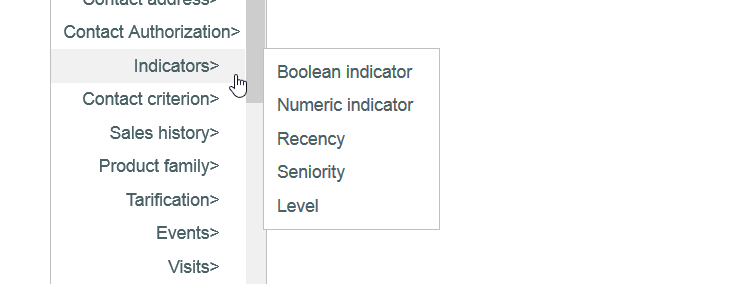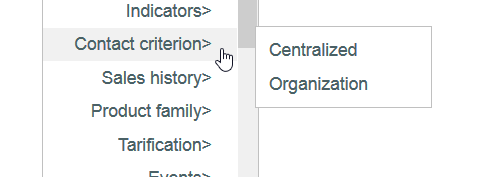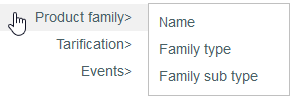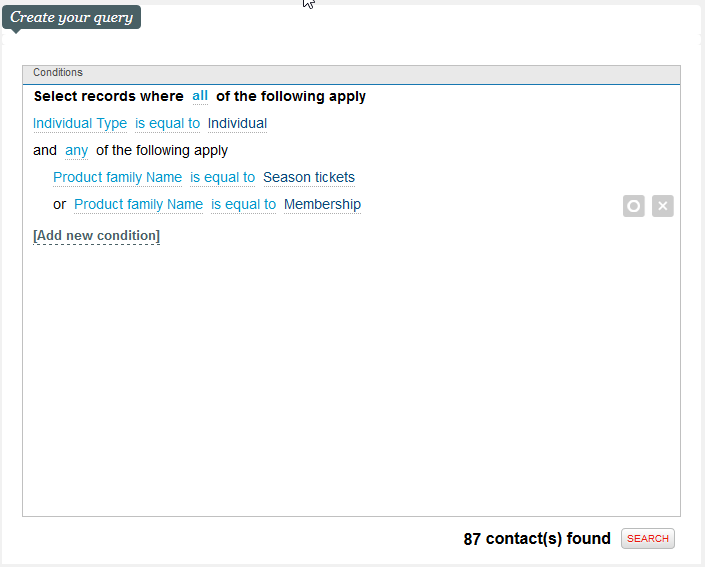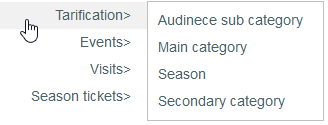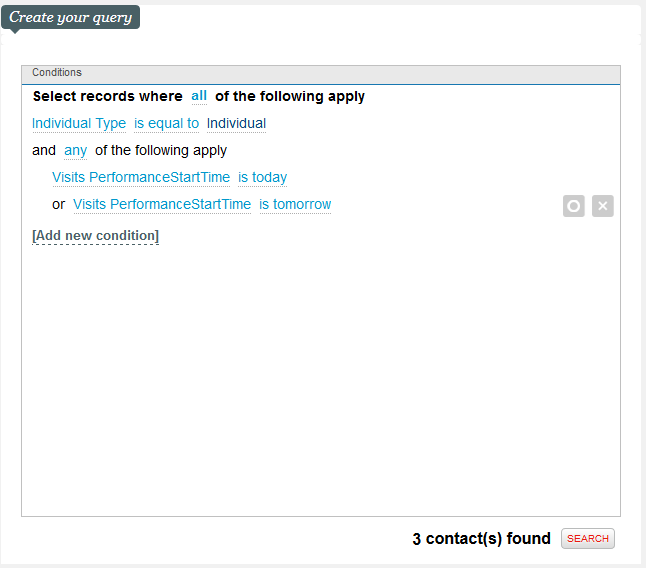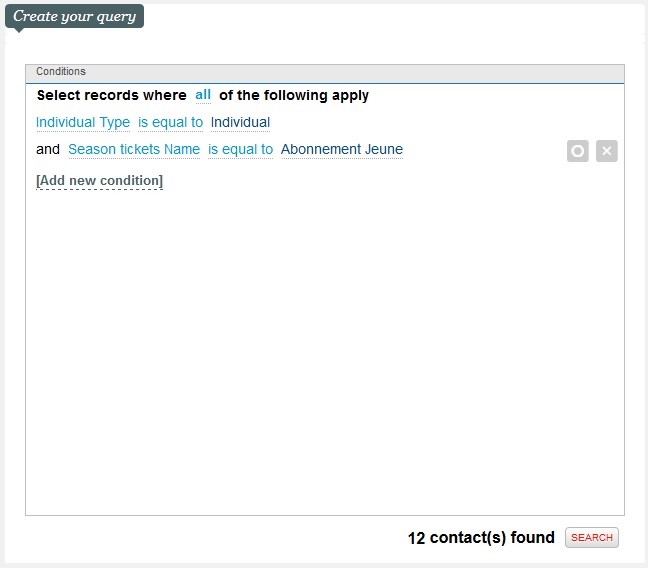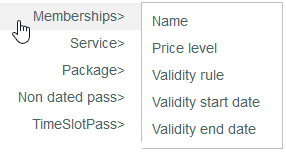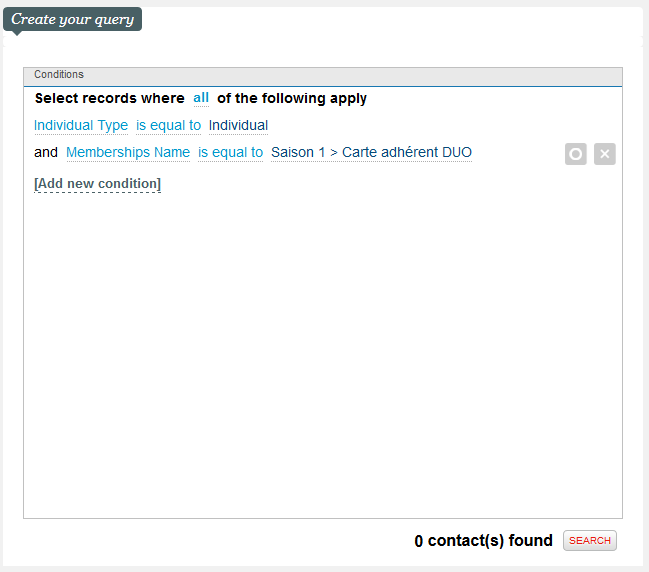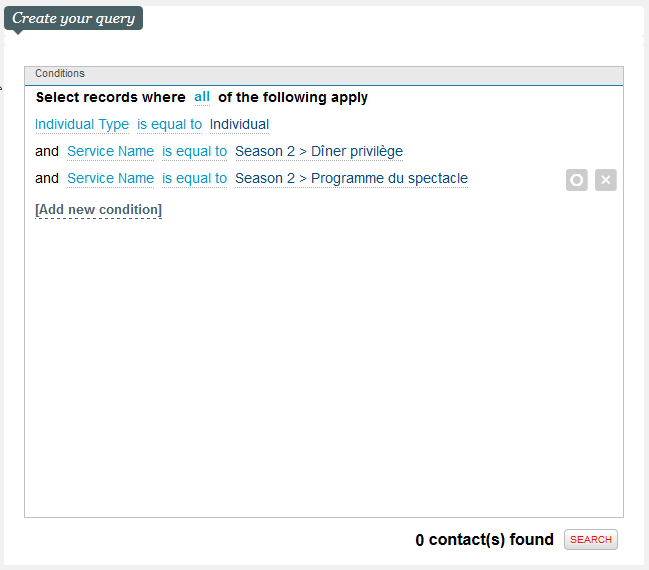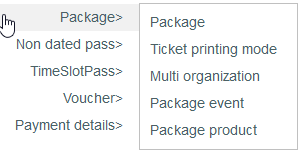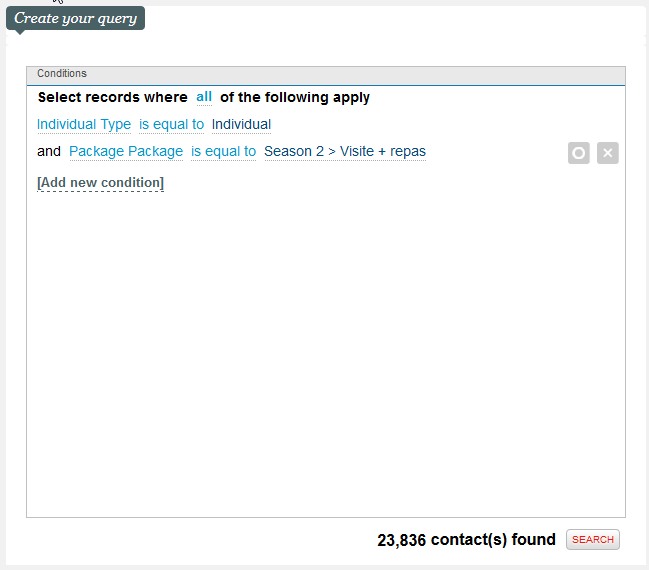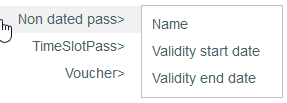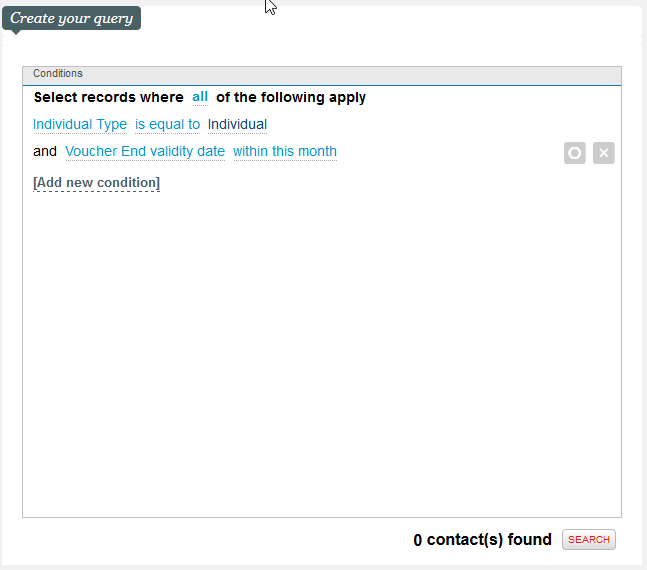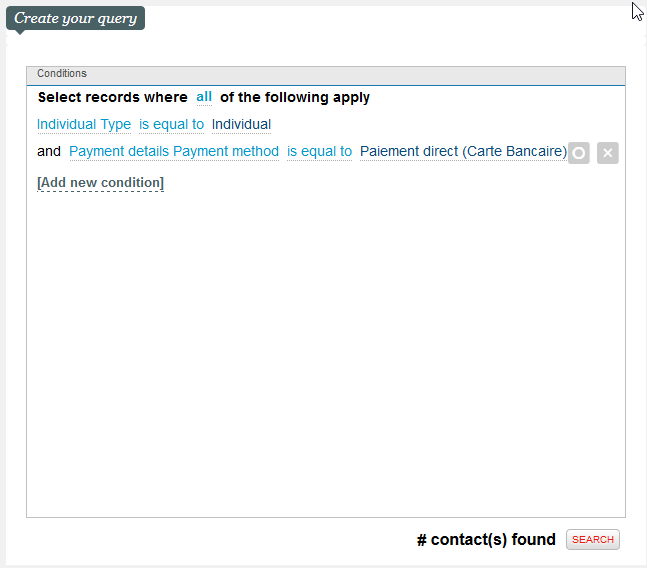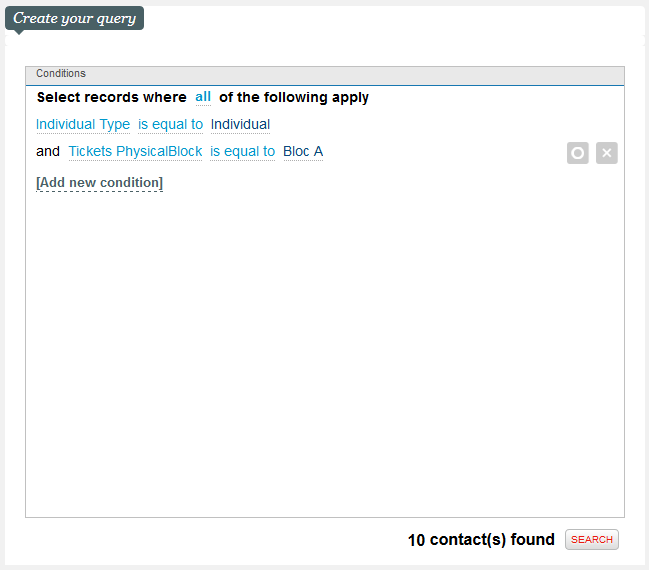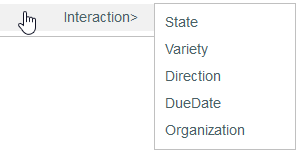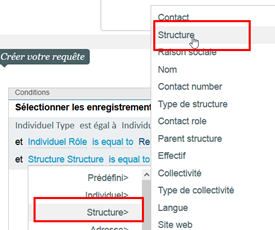SecuTix Query Engine
SecuTix comprises an engine for the creation of queries called "SecuTixQuery Engine".
These are some explanations and examples that will help you master your contact base and your segmentation.
A: The beginning of the query
The query engine enables you to construct a query as naturally as if you were constructing a sentence. The beginning of your sentence is always the same: "Select the records where all the following conditions apply".
You can choose between 4 different possibilities depending on what you want to do:
- All (+ / and): enables to add contacts to the list and to link conditions with an and
- At least one (+ / or): enables to add contacts to the list and to link the conditions with an or
- At least not one (- / or): allows the exclusion of contacts to the list and to link the conditions with an or
- No (- / and): enables to exclude contacts from the list and to link conditions with an and
The modification of this block thus allows you to create queries with the operator OR and/or "negative" operators. In other words:
| Link conditions with: and | Link conditions with: or |
Add contacts (+) | All (+ / and) | At least one (+ / or) |
Exclude contacts (-) | No (- / and) | At least not one (- / or) |
B: The list of conditions
Here, you will be able to determine the conditions of your query. The component "Add new condition" allows you to add one condition in a click.
C: Add/handle the conditions of a query
These four buttons will allow you to:
- + Add a new condition / sub-conditions
- {+} Add a sub query
- O Momentarily deactivate a condition
- x Delete a condition
D: Execute the query and view the resulting volume
A simple click on "Search" allows you to see the volume of contacts that meet the conditions laid down and to gain access to the sample of some contacts.
Most used queries
The "SecuTixQuery Engine" has a notable innovation, when you click on "Add new condition", you can choose in the first instance among the most used queries in SecuTix.
You can also simply construct your conditions on all other data made available. Let's take a closer look at these different possibilities with some examples.
The "Predefined" entry contains the list of the conditions mostly used by SecuTix customers.
This is a description that explains in more detail the meaning of each of these predefined conditions.
Contact has not printed print@home ticket for - contacts who have not printed their print@home ticket for the event X
Contact is a member of - contacts being subscribers of the X organization (the indicator Member shows yes for the organization X).
Contact is season ticket holder of - contacts who are subscribers of the organization X (The Subscriber indicator is yes for the organization X)
Contact used advantage - contacts who have used the advantage X and who have not been reimbursed.
Contact didn't use advantage - contacts who have not used the advantage X (buyers contacts that have been subsequently reimbursed are excluded from the result).
Contact has bought more than - contacts having bought for an amount exceeding X over all seasons.
Contact has bought less than - contacts having bought for an amount lower than X over all seasons.
Contact has paid for product - contacts having paid for the product X (buyer contact/financial history).
Contact is in static target - contacts being members of the static target X.
Entities
The SecuTixQuery Engine enables you to combine these conditions together. Let's now take a closer look at the available data/entities to create your queries.
For each entity below, you will find a typical example of use. We have selected the most interesting data for you to provide an intuitive and natural experience in the creation of your queries.
Individual / Structure
The main Information of your contact forms are available here, that is, the email, the anniversary date, the source sales channel or the presence of a login. You have general information for the creation of your targets.
In the same way, when you choose to create a structure target, you will have the structure entity here to construct your query.
The example to the right presents a query combining several operators and several fields of the individual entity. This query will enable us to have the list of individuals who have an email and a login name that have been created within the current month on the sales channel "Internet B2C" or "Internet B2B".
Example
Address
Geographic and postal Information of your contacts are available here.
The example to the right presents a query combining several operators and several fields of the entity address. It allows you to have the list of all individuals living in Switzerland or France.
Example
Authorization
CNIL information and authorizations for disclosure of your contacts are available here.
The example presents a query that allows you to have the list of all individuals accepting communications from your organization.
Example
Indicators
The data calculated automatically by SecuTix depending on the behaviour and on the consumption of your contacts are available here. To carry out a query based on an indicator, you need to know above all the types of possible values for your indicator: boolean (yes/no), number, etc.
You should also remember that indicators have a level and a value. For example, the indicator "Assiduity" will have an occasional value and the level will be 1 since the contact returned once, thus classifying him in the category of occasional contacts
The example presents a query that enables you to have the list of all individuals having the Social media engagement (shares) with the Engaged value.
Example
Contact criteria
Qualification data of your contacts are available here. In SecuTix, if you have many organizations, the criteria can be centralized, that is, the value is common to all organizations or they can be specific to an organization, and each organization can therefore determine a value specific to its organization.
The example presents a query enabling to have the list of all individuals who prefer to be contacted by mail.
Example
Sales history
Information relating to purchases carried by your contacts are available here.
The example on the right presents a query combining several operators and several fields of the Sales history entity. It enables you to obtain the list of all individuals who have made a purchase during the season on the sales channel "Internet B2C" or "Ticket office".
Example
Product family
Information relating to product families purchased by your contacts are available here.
The example on the right presents a query combining several operators and several fields of the Product family entity. It enables you to have the list of all individuals who purchased product families, a subscription product or a membership.
Example
Tarification
Information relating to rates configured in SecuTix are available here.
The example to the right presents a query combining several operators and several fields of the Tarification entity. It enables you to have the list of all individuals who have purchased in the sub-category "Youth" audience.
Example
Events
Information relating to the Events product family purchased by your contacts are available here.
The example to the right presents a query combining several operators and several fields of the Events entity. It will enable you to have the list of all individuals who purchased seats for "Aïda" or "La Traviata".
Example
Visits
Information relating to the Visits product family purchased by your contacts are available here.
The example to the right presents a query that combines several operators and several fields of the Visits entity. It enables you to have the list of all individuals who purchased tickets for today's or tomorrow's visits.
Example
Season Tickets
Data relating to the Season tickets product family purchased by your contacts are available here.
The example to the right presents a query combining several operators and several fields of the Season Tickets entity. It enables you to have the list of all individuals who have purchased the "Youth membership".
Example
Membership
Data relating to the Membership product family purchased by your contacts are available here.
The example to the right presents a query combining several operators and several fields of the Membership entity. It enables you to have the list of all individuals who purchased the "DUO membership card".
Example
Services
Data relating to the Services product family purchased by your contacts are available here.
The example to the right presents a query combining several operators and several fields of the Service entity. It enables you to have the list of all individuals who purchased the "Dînerprivilège" service and the "Programme du spectacle" service.
Example
Package
Data relating to the Package product family items purchased by your contacts are available here.
The example to the right presents a query combining several operators and several fields of the Package entity. It enables you to retrieve the list of all individuals who have purchased the "Visite + repas" package.
Example
Not dated pass/ Time-slot pass
Data relating to product family not dated pass/time-slot pass purchased by your contacts are available here.
The example to the right presents a query that combines several operators and several fields of the Not dated pass/Time-slot pass entity. It enables you to have the list of all individuals who have a pass for the "One day visit Studio".
Example
Voucher
Data relating to product family Voucher purchased by your contacts are available here.
The example to the right presents a query combining several operators and several fields of the Voucher entity. It enables you to retrieve the list of all individuals who purchased vouchers that will expire within the current month.
Example
Payment details
Data relating to payment details carried out by your contacts are available here.
The example to the right presents a query that combines several operators and several fields of the Payment details entity. It enables you to retrieve the list of all individuals who purchased tickets with the "Credit card" payment method.
Example
Shipments
Data relating to shipments carried out to your contacts are available here.
The example to the right presents a query combining several operators and several fields of the Shipments entity. It enables you to have the list of all individuals who received an email during the "September Newsletter" or "-20% Personal Offer" campaigns.
Example
Tickets
Data relating to your contacts' tickets are available here.
The example to the right presents a query combining several operators and several fields of the Tickets entity. It enables you to retrieve the list of all individuals who have a ticket for a seat in "bloc B".
Example
Interactions
Data relating to interactions between your contacts and your institution are available here.
The example to the right presents a query combining several operators and several fields of the Interaction entity. It enables you to have the list of all individuals who have had an entering interaction such as "Phone call".
Example
Complex queries
In complex cases you may need to use sub queries when creating your marketing targets. The sub queries allow you to make a search in a group of sub-conditions within the main query.
This can be compared with the brackets used in mathematics to separate the parts of an equation that must be solved first before solving the equation.
For example: 10 x 5 – ( 3+2 ) = 45 and 10 x 5 - 3 + 2 = 49 are not the same.
In this example, it is important to add 3 and 2 before subtracting them from the multiplication.
This is like the complex queries!
Here you can find the sub queries:
